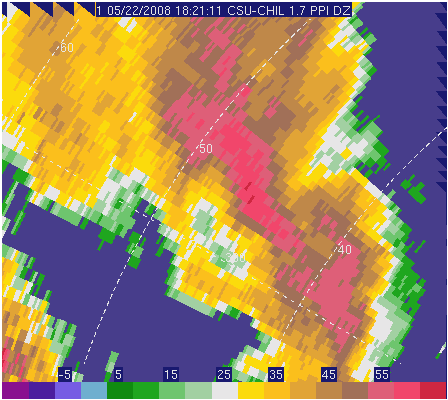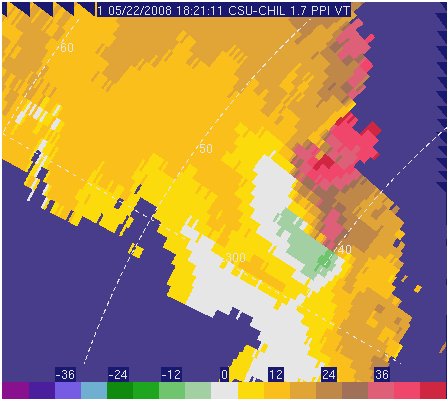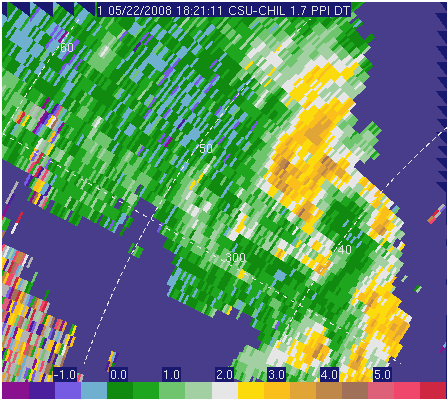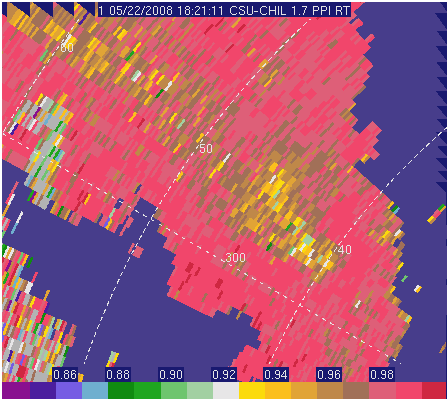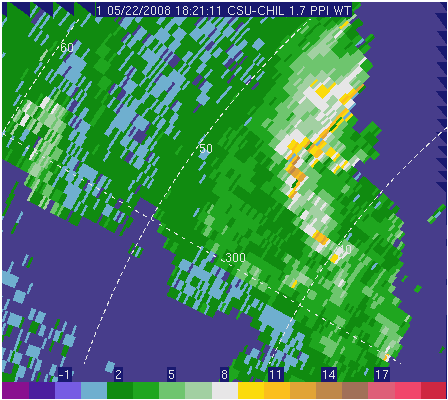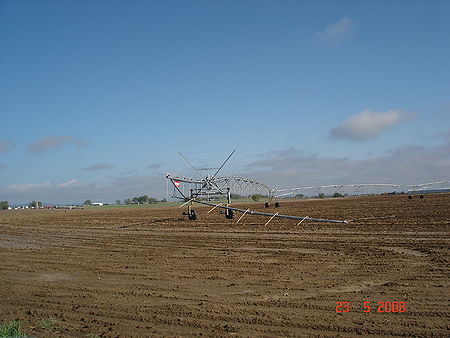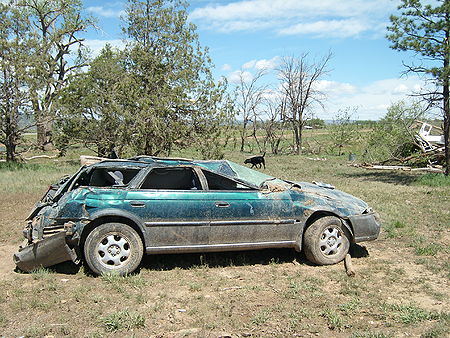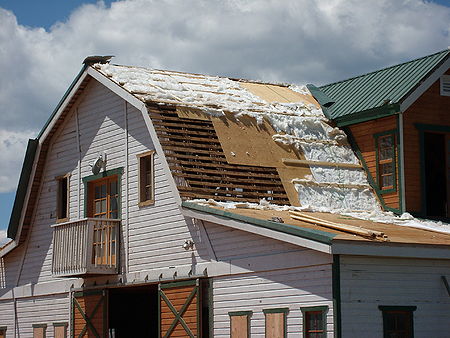Tornado Observation from May 22, 2008: Difference between revisions
Pat kennedy (talk | contribs) No edit summary |
m (→Polarimetric observations: Changed note format) |
||
| (19 intermediate revisions by 2 users not shown) | |||
| Line 1: | Line 1: | ||
This article describes a recent observation of a '''tornado''' that passed close to '''Fort Collins, CO '''on '''May 22, 2008'''. | |||
==Introduction== | |||
A tornadic supercell thunderstorm moved across parts of Weld and Larimer counties around mid-day local time on May 22, 2008. The town of '''Windsor, Colorado''' experienced extensive damage. On this date, the [[Facilities#CSU-CHILL|CSU-CHILL radar's]] antenna control system was being adapted to the new dual offset feed antenna, so routine data collection operations were not possible. Once National Weather Service tornado warnings were issued, however, the radar was brought up with limited antenna motion capability. These efforts were hampered by commercial power fluctuations that were probably related to easterly surface winds that were gusting above 40 knots at the Greeley Airport. | |||
==Radar Data and Ground Observations== | |||
CSU-CHILL data collection began shortly after the northwest-bound storm had crossed I-25 north of Ft. Collins. A survey of the region west of I-25 and north of Ft. Collins revealed spotty damage along the storm track. (This area was just beyond the end of storm's overall tornadic damage path as identified in a post-event survey conducted by the Boulder NWS office.) Damage observations are marked as placemarks on the Google Maps presentation shown below. The most significant damage (a flipped car and RV; removed roof sections, etc.) was found at the two northwestern-most landmarks. | |||
===Google Maps presentation=== | |||
The figure below is an interactive presentation of the radar observations. Clicking on the placemarks ([[Image:placemark.png]]) expands them, showing observed damage on the ground. The 1.4° elevation angle PPI scan data was collected at 1830 UTC when the radial velocity rotation signature was nearest to the primary ground damage location. The red line indicates the approximate path of the tornado, according to the NOAA damage report. | |||
<gmap lat="40.65" long="-105.05" zoom="12" width="650" height="650" showlabels="on" showscale="on"> | <gmap lat="40.65" long="-105.05" zoom="12" width="650" height="650" showlabels="on" showscale="on"> | ||
points: | points: | ||
40.66473|-105.01583|'''Irrigation Pivot''' [[Image:Pivot damage.jpg|150px]] Only isolated damage like this disrupted irrigation pivot, was found immediately west of I-25. | 40.66473|-105.01583|'''Irrigation Pivot''' <br>[[Image:Pivot damage.jpg|150px]]<br>Only isolated damage like this disrupted irrigation pivot, was found immediately west of I-25. '''[[Tornado_Observation_from_May_22%2C_2008#Irrigation_Pivot|(more)]]''' | ||
40.68169|-105.07159|An outbuilding was tipped over at this location. (Photograph not currently available.) | 40.68169|-105.07159|An outbuilding was tipped over at this location. (Photograph not currently available.) | ||
40.71173|-105.09533|'''House''' [[Image:Parked car damage.jpg|150px]] This parked car was swept around the corner of a house and rolled over. | 40.71173|-105.09533|'''House''' <br>[[Image:Parked car damage.jpg|150px]] <br>This parked car was swept around the corner of a house and rolled over. '''[[Tornado_Observation_from_May_22%2C_2008#Overturned_Car|(more)]]''' | ||
40.71812|-105.09726|'''Barn''' [[Image:Roof damage.jpg|150px]] Portions of this well-constructed barn roof were removed. | 40.71812|-105.09726|'''Barn''' <br>[[Image:Roof damage.jpg|150px]] <br>Portions of this well-constructed barn roof were removed. '''[[Tornado_Observation_from_May_22%2C_2008#Roof_Damage|(more)]]''' | ||
http://www.chill.colostate.edu/w/Tornado_Observation_from_May_22%2C_2008#Irrigation_Pivot | |||
lines: | |||
ff0000|5|0.75|40.262499|-104.771118|40.280311|-104.798241|40.330057|-104.810257|40.377936|-104.836349|40.438325|-104.869995|40.485865|-104.889908|40.550070|-104.942093|40.591014|-104.952049|40.640270|-104.985008|40.667879|-105.006638|40.682200|-105.020027 | |||
kml: | kml: | ||
http://www.chill.colostate.edu/kml/20080522/CHL_1823_dBZ_5.kml|dBZ | http://www.chill.colostate.edu/kml/20080522/CHL_1823_dBZ_5.kml|dBZ | ||
| Line 13: | Line 30: | ||
</gmap> | </gmap> | ||
====Animation==== | |||
<gmap lat="40.65" long="-105.05" zoom="12" width="650" height="650" showlabels="on" showscale="on"> | |||
points: | |||
40.66473|-105.01583|'''Irrigation Pivot''' <br>[[Image:Pivot damage.jpg|150px]]<br>Only isolated damage like this disrupted irrigation pivot, was found immediately west of I-25. '''[[Tornado_Observation_from_May_22%2C_2008#Irrigation_Pivot|(more)]]''' | |||
40.68169|-105.07159|An outbuilding was tipped over at this location. (Photograph not currently available.) | |||
40.71173|-105.09533|'''House''' <br>[[Image:Parked car damage.jpg|150px]] <br>This parked car was swept around the corner of a house and rolled over. '''[[Tornado_Observation_from_May_22%2C_2008#Overturned_Car|(more)]]''' | |||
40.71812|-105.09726|'''Barn''' <br>[[Image:Roof damage.jpg|150px]] <br>Portions of this well-constructed barn roof were removed. '''[[Tornado_Observation_from_May_22%2C_2008#Roof_Damage|(more)]]''' | |||
http://www.chill.colostate.edu/w/Tornado_Observation_from_May_22%2C_2008#Irrigation_Pivot | |||
lines: | |||
ff0000|5|0.75|40.262499|-104.771118|40.280311|-104.798241|40.330057|-104.810257|40.377936|-104.836349|40.438325|-104.869995|40.485865|-104.889908|40.550070|-104.942093|40.591014|-104.952049|40.640270|-104.985008|40.667879|-105.006638|40.682200|-105.020027 | |||
kml: | |||
http://www.chill.colostate.edu/kml/20080522/CHL_1823_dBZ_a.kml|dBZ | |||
http://www.chill.colostate.edu/kml/20080522/CHL_1823_Vel_a.kml|Velocity | |||
http://www.chill.colostate.edu/kml/20080522/CHL_1823_Wid_a.kml|Spectrum Width | |||
http://www.chill.colostate.edu/kml/20080522/CHL_1823_RHO_a.kml|Rho | |||
http://www.chill.colostate.edu/kml/20080522/CHL_1823_ZDR_a.kml|ZDR | |||
</gmap> | |||
==Polarimetric observations== | |||
Some interesting radar data values are found in the rotation area: On the inbound side, <math>Z_{dr}</math> values are significantly more positive than the near 0 dB differential reflectivity levels typically found in hail. For example, a near 0 dB <math>Z_{dr}</math> / high reflectivity hail signature is present in the southern part of the echo system over northern Ft. Collins. The co-polar H,V correlation (<math>\rho_{hv}</math>) values in the southwestern half of the circulation are slightly reduced from the typical "pure rain" levels (> ~0.98). Prior research <ref name="ryzhkov">Ryzhkov et al, ''Bulletin of the American Meteorological Society'', (June, 2005)</ref> has associated significant <math>\rho_{hv}</math> reductions (sometimes less than 0.5) in the immediate vicinity of tornadoes with echo returns from lofted debris. The <math>\rho_{hv}</math> reductions seen here are not particularly large, but only remnants of the tornado existed at 1830 UTC. One region of high radial velocity spectral widths was essentially co-located with the flipped car landmark. This high spectral width patch may have been related to sub-pulse volume scale circulations. | |||
Note: The radar was operating in simultaneous VHS (simultaneous transmit) mode during the time period shown here. The moment fields were calculated in post-processing from archived time series data; no clutter filtering was applied. | |||
These results are preliminary; additional, more extensive data analysis are anticipated in the future. | These results are preliminary; additional, more extensive data analysis are anticipated in the future. | ||
===Time-lapse=== | |||
====Reflectivity==== | |||
<center> | |||
<imgloop delay=400 imgprefix="http://www.chill.colostate.edu/anim/20080522_tornado/" width=448 height=400> | |||
png.1080522182111.CSU-CHIL.0_1.7_PPI_DZ.png | |||
png.1080522182227.CSU-CHIL.0_1.7_PPI_DZ.png | |||
png.1080522182310.CSU-CHIL.0_1.7_PPI_DZ.png | |||
png.1080522182412.CSU-CHIL.0_1.7_PPI_DZ.png | |||
png.1080522182514.CSU-CHIL.0_1.7_PPI_DZ.png | |||
png.1080522182612.CSU-CHIL.0_1.7_PPI_DZ.png | |||
png.1080522182706.CSU-CHIL.0_1.7_PPI_DZ.png | |||
png.1080522182808.CSU-CHIL.0_1.7_PPI_DZ.png | |||
png.1080522182909.CSU-CHIL.0_1.7_PPI_DZ.png | |||
</imgloop> | |||
</center> | |||
====Velocity==== | |||
<center> | |||
<imgloop delay=400 imgprefix="http://www.chill.colostate.edu/anim/20080522_tornado/" width=448 height=400> | |||
png.1080522182111.CSU-CHIL.0_1.7_PPI_VT.png | |||
png.1080522182227.CSU-CHIL.0_1.7_PPI_VT.png | |||
png.1080522182310.CSU-CHIL.0_1.7_PPI_VT.png | |||
png.1080522182412.CSU-CHIL.0_1.7_PPI_VT.png | |||
png.1080522182514.CSU-CHIL.0_1.7_PPI_VT.png | |||
png.1080522182612.CSU-CHIL.0_1.7_PPI_VT.png | |||
png.1080522182706.CSU-CHIL.0_1.7_PPI_VT.png | |||
png.1080522182808.CSU-CHIL.0_1.7_PPI_VT.png | |||
png.1080522182909.CSU-CHIL.0_1.7_PPI_VT.png | |||
</imgloop> | |||
</center> | |||
====Differential Reflectivity==== | |||
<center> | |||
<imgloop delay=400 imgprefix="http://www.chill.colostate.edu/anim/20080522_tornado/" width=448 height=400> | |||
png.1080522182111.CSU-CHIL.0_1.7_PPI_DT.png | |||
png.1080522182227.CSU-CHIL.0_1.7_PPI_DT.png | |||
png.1080522182310.CSU-CHIL.0_1.7_PPI_DT.png | |||
png.1080522182412.CSU-CHIL.0_1.7_PPI_DT.png | |||
png.1080522182514.CSU-CHIL.0_1.7_PPI_DT.png | |||
png.1080522182612.CSU-CHIL.0_1.7_PPI_DT.png | |||
png.1080522182706.CSU-CHIL.0_1.7_PPI_DT.png | |||
png.1080522182808.CSU-CHIL.0_1.7_PPI_DT.png | |||
png.1080522182909.CSU-CHIL.0_1.7_PPI_DT.png | |||
</imgloop> | |||
</center> | |||
====Correlation Coefficient==== | |||
<center> | |||
<imgloop delay=400 imgprefix="http://www.chill.colostate.edu/anim/20080522_tornado/" width=448 height=400> | |||
png.1080522182111.CSU-CHIL.0_1.7_PPI_RT.png | |||
png.1080522182227.CSU-CHIL.0_1.7_PPI_RT.png | |||
png.1080522182310.CSU-CHIL.0_1.7_PPI_RT.png | |||
png.1080522182412.CSU-CHIL.0_1.7_PPI_RT.png | |||
png.1080522182514.CSU-CHIL.0_1.7_PPI_RT.png | |||
png.1080522182612.CSU-CHIL.0_1.7_PPI_RT.png | |||
png.1080522182706.CSU-CHIL.0_1.7_PPI_RT.png | |||
png.1080522182808.CSU-CHIL.0_1.7_PPI_RT.png | |||
png.1080522182909.CSU-CHIL.0_1.7_PPI_RT.png | |||
</imgloop> | |||
</center> | |||
====Spectrum Width==== | |||
<center> | |||
<imgloop delay=400 imgprefix="http://www.chill.colostate.edu/anim/20080522_tornado/" width=448 height=400> | |||
png.1080522182111.CSU-CHIL.0_1.7_PPI_WT.png | |||
png.1080522182227.CSU-CHIL.0_1.7_PPI_WT.png | |||
png.1080522182310.CSU-CHIL.0_1.7_PPI_WT.png | |||
png.1080522182412.CSU-CHIL.0_1.7_PPI_WT.png | |||
png.1080522182514.CSU-CHIL.0_1.7_PPI_WT.png | |||
png.1080522182612.CSU-CHIL.0_1.7_PPI_WT.png | |||
png.1080522182706.CSU-CHIL.0_1.7_PPI_WT.png | |||
png.1080522182808.CSU-CHIL.0_1.7_PPI_WT.png | |||
png.1080522182909.CSU-CHIL.0_1.7_PPI_WT.png | |||
</imgloop> | |||
</center> | |||
==Ground Damage== | |||
===Irrigation Pivot=== | |||
<center> | |||
[[Image:Pivot damage.jpg|450px]] | |||
</center> | |||
Only isolated damage like this disrupted irrigation pivot, was found immediately west of I-25. Picture courtesy Miguel Galvez. | |||
===Overturned Car=== | |||
<center> | |||
[[Image:Parked car damage.jpg|450px]] | |||
</center> | |||
This parked car was swept around the corner of a house and rolled over. Picture courtesy Pat Kennedy. | |||
===Roof Damage=== | |||
<center> | |||
[[Image:Roof damage.jpg|450px]] | |||
</center> | |||
Portions of this well-constructed barn roof were removed. Picture courtesy Pat Kennedy. | |||
==External References and Links== | |||
===References=== | |||
<references/> | |||
===Links=== | |||
* [http://www.spc.noaa.gov/products/watch/ww0334.html Storm Prediction Center Tornado Watch 334] | |||
* [http://www.crh.noaa.gov/news/display_cmsstory.php?wfo=bou&storyid=8556&source=0 Weld county tornado of May 22 2008 rated an EF3 tornado] - Official NOAA damage report | |||
* [http://www.9news.com/9slideshows/Weld%20County%20Tornado%205-22-08/Default.aspx?N=135 9news image of the tornado] | |||
[[Category:Casebook|20080522]] | |||
[[Category:Tornado]] | |||
[[Category:Featured Articles]] | |||
Latest revision as of 22:28, 20 April 2010
This article describes a recent observation of a tornado that passed close to Fort Collins, CO on May 22, 2008.
Introduction
A tornadic supercell thunderstorm moved across parts of Weld and Larimer counties around mid-day local time on May 22, 2008. The town of Windsor, Colorado experienced extensive damage. On this date, the CSU-CHILL radar's antenna control system was being adapted to the new dual offset feed antenna, so routine data collection operations were not possible. Once National Weather Service tornado warnings were issued, however, the radar was brought up with limited antenna motion capability. These efforts were hampered by commercial power fluctuations that were probably related to easterly surface winds that were gusting above 40 knots at the Greeley Airport.
Radar Data and Ground Observations
CSU-CHILL data collection began shortly after the northwest-bound storm had crossed I-25 north of Ft. Collins. A survey of the region west of I-25 and north of Ft. Collins revealed spotty damage along the storm track. (This area was just beyond the end of storm's overall tornadic damage path as identified in a post-event survey conducted by the Boulder NWS office.) Damage observations are marked as placemarks on the Google Maps presentation shown below. The most significant damage (a flipped car and RV; removed roof sections, etc.) was found at the two northwestern-most landmarks.
Google Maps presentation
The figure below is an interactive presentation of the radar observations. Clicking on the placemarks (![]() ) expands them, showing observed damage on the ground. The 1.4° elevation angle PPI scan data was collected at 1830 UTC when the radial velocity rotation signature was nearest to the primary ground damage location. The red line indicates the approximate path of the tornado, according to the NOAA damage report.
) expands them, showing observed damage on the ground. The 1.4° elevation angle PPI scan data was collected at 1830 UTC when the radial velocity rotation signature was nearest to the primary ground damage location. The red line indicates the approximate path of the tornado, according to the NOAA damage report.
<gmap lat="40.65" long="-105.05" zoom="12" width="650" height="650" showlabels="on" showscale="on">
points:
40.66473|-105.01583|Irrigation Pivot 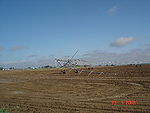
Only isolated damage like this disrupted irrigation pivot, was found immediately west of I-25. (more)
40.68169|-105.07159|An outbuilding was tipped over at this location. (Photograph not currently available.)
40.71173|-105.09533|House 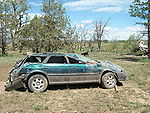
This parked car was swept around the corner of a house and rolled over. (more)
40.71812|-105.09726|Barn 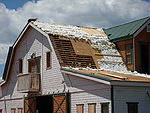
Portions of this well-constructed barn roof were removed. (more)
http://www.chill.colostate.edu/w/Tornado_Observation_from_May_22%2C_2008#Irrigation_Pivot
lines: ff0000|5|0.75|40.262499|-104.771118|40.280311|-104.798241|40.330057|-104.810257|40.377936|-104.836349|40.438325|-104.869995|40.485865|-104.889908|40.550070|-104.942093|40.591014|-104.952049|40.640270|-104.985008|40.667879|-105.006638|40.682200|-105.020027
kml: http://www.chill.colostate.edu/kml/20080522/CHL_1823_dBZ_5.kml%7CdBZ http://www.chill.colostate.edu/kml/20080522/CHL_1823_Vel_5.kml%7CVelocity http://www.chill.colostate.edu/kml/20080522/CHL_1823_Wid_5.kml%7CSpectrum Width http://www.chill.colostate.edu/kml/20080522/CHL_1823_RHO_5.kml%7CRho http://www.chill.colostate.edu/kml/20080522/CHL_1823_ZDR_5.kml%7CZDR </gmap>
Animation
<gmap lat="40.65" long="-105.05" zoom="12" width="650" height="650" showlabels="on" showscale="on">
points:
40.66473|-105.01583|Irrigation Pivot 
Only isolated damage like this disrupted irrigation pivot, was found immediately west of I-25. (more)
40.68169|-105.07159|An outbuilding was tipped over at this location. (Photograph not currently available.)
40.71173|-105.09533|House 
This parked car was swept around the corner of a house and rolled over. (more)
40.71812|-105.09726|Barn 
Portions of this well-constructed barn roof were removed. (more)
http://www.chill.colostate.edu/w/Tornado_Observation_from_May_22%2C_2008#Irrigation_Pivot
lines: ff0000|5|0.75|40.262499|-104.771118|40.280311|-104.798241|40.330057|-104.810257|40.377936|-104.836349|40.438325|-104.869995|40.485865|-104.889908|40.550070|-104.942093|40.591014|-104.952049|40.640270|-104.985008|40.667879|-105.006638|40.682200|-105.020027
kml: http://www.chill.colostate.edu/kml/20080522/CHL_1823_dBZ_a.kml%7CdBZ http://www.chill.colostate.edu/kml/20080522/CHL_1823_Vel_a.kml%7CVelocity http://www.chill.colostate.edu/kml/20080522/CHL_1823_Wid_a.kml%7CSpectrum Width http://www.chill.colostate.edu/kml/20080522/CHL_1823_RHO_a.kml%7CRho http://www.chill.colostate.edu/kml/20080522/CHL_1823_ZDR_a.kml%7CZDR </gmap>
Polarimetric observations
Some interesting radar data values are found in the rotation area: On the inbound side, values are significantly more positive than the near 0 dB differential reflectivity levels typically found in hail. For example, a near 0 dB / high reflectivity hail signature is present in the southern part of the echo system over northern Ft. Collins. The co-polar H,V correlation () values in the southwestern half of the circulation are slightly reduced from the typical "pure rain" levels (> ~0.98). Prior research [1] has associated significant reductions (sometimes less than 0.5) in the immediate vicinity of tornadoes with echo returns from lofted debris. The reductions seen here are not particularly large, but only remnants of the tornado existed at 1830 UTC. One region of high radial velocity spectral widths was essentially co-located with the flipped car landmark. This high spectral width patch may have been related to sub-pulse volume scale circulations.
Note: The radar was operating in simultaneous VHS (simultaneous transmit) mode during the time period shown here. The moment fields were calculated in post-processing from archived time series data; no clutter filtering was applied.
These results are preliminary; additional, more extensive data analysis are anticipated in the future.
Time-lapse
Reflectivity
|
|
||
|
Velocity
|
|
||
|
Differential Reflectivity
|
|
||
|
Correlation Coefficient
|
|
||
|
Spectrum Width
|
|
||
|
Ground Damage
Irrigation Pivot
Only isolated damage like this disrupted irrigation pivot, was found immediately west of I-25. Picture courtesy Miguel Galvez.
Overturned Car
This parked car was swept around the corner of a house and rolled over. Picture courtesy Pat Kennedy.
Roof Damage
Portions of this well-constructed barn roof were removed. Picture courtesy Pat Kennedy.
External References and Links
References
- ↑ Ryzhkov et al, Bulletin of the American Meteorological Society, (June, 2005)
Links
- Storm Prediction Center Tornado Watch 334
- Weld county tornado of May 22 2008 rated an EF3 tornado - Official NOAA damage report
- 9news image of the tornado


